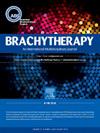GSOR06 演讲时间:下午 5:25
IF 1.7
4区 医学
Q4 ONCOLOGY
引用次数: 0
摘要
目的 慢性抗凝(AC)患者是手术、妇科(gyn)、腔内(IC)和间质(IS)近距离放射治疗(brachy)的一个挑战。通常情况下,为了使用硬膜外导管进行麻醉和疼痛控制,并最大限度地降低插入和拔出涂抹器时的出血风险,需要暂时停止近距离放射治疗。由于患者固定不动、手术、癌症诊断和合并症等原因,在硬膜外麻醉过程中存在血栓栓塞的重大风险,这就使情况变得更加复杂。目前还没有关于妇科手术穿刺患者血栓栓塞治疗的指南。因此,本研究旨在评估我们的实践方法对患有慢性 AC 的血栓栓塞性疾病、接受妇科恶性肿瘤手术支架治疗的患者的安全性和有效性。材料和方法经 IRB 批准后,我们回顾了 2013 年至 2022 年期间连续接受妇科恶性肿瘤手术支架治疗的 277 例患者的记录,确定了 30 例患有需要 AC 治疗的围手术期或慢性血栓栓塞性疾病的患者。我们确定了使用 AC 的适应症、手术指标、肿瘤和胸骨特点、AC 中断持续时间以及手术或术后并发症。主要目的是根据不良事件通用术语标准(CTCAE)确定手术或术后(90 天内)的栓塞或出血并发症。结果中位年龄为 66 岁(35-80 岁),患者接受治疗的癌症包括宫颈癌(14 例)、无法手术的子宫癌(11 例)、复发性子宫癌(2 例)和阴道癌(3 例)。术后中位随访时间为 9 个月(0-70 个月)。AC 治疗的适应症为深静脉血栓(13 例)、肺栓塞(8 例)和心房颤动/扑动(11 例)。使用的 AC 药物有阿哌沙班(17 例)、依诺肝素(5 例)、利伐沙班(3 例)、华法林(2 例)和静脉肝素(3 例)。植入物为 IC(14 例)、IS(7 例)和 IC/IS 联合植入物(9 例),每位患者植入物的中位数为 2 个(1-3 个不等),4 个(2-9 个不等)支架。16名患者在手术前接受了硬膜外麻醉。26名患者在胸骨切开术前使用了交流电,4名患者在围手术期开始使用交流电。24名患者在手术前接受了治疗性交流。在手术前和手术后,治疗用药中断的总时间中位数分别为 2 天(0-16 天)和 1 天(0-4 天),治疗用药中断的总时间中位数为 4 天。大多数患者在置入涂抹器后都采取了深静脉血栓预防措施,其中包括IVC 过滤器(3 例)、皮下肝素(15 例)、静脉肝素(1 例)、预防剂量依诺肝素(5 例)、治疗剂量依诺肝素(2 例)。每次植入的卧床固定天数中位数为 1 天(1-8 天不等)。只有 3 名患者(10%)出现了 CTCAE ≥ 2 级的手术或术后并发症,没有出现 4 级或 5 级并发症。一名患者术后出现 2 级阴道出血,在门诊接受了美加净治疗。第二位患者在严重血小板减少的情况下出现了术后 3 级阴道出血,需要输血和阴道填塞。结论我们观察到,在我们的队列中,≥2级的手术或术后栓塞或出血并发症发生率较低,可以接受。在使用 AC 的围手术期或慢性血栓栓塞性疾病患者中,IC 和 IS 手术支架配合频繁使用硬膜外导管和卧床似乎是安全的。本文章由计算机程序翻译,如有差异,请以英文原文为准。
GSOR06 Presentation Time: 5:25 PM
Purpose
Patients on chronic anticoagulation (AC) represent a challenge for operative, gynecologic (gyn), intracavitary (IC) and interstitial (IS) brachytherapy (brachy). Frequently, AC is temporarily held to permit use of epidural catheters for anesthesia and pain control, and to minimize the risk of bleeding during applicator insertion and removal. This is complicated by significant risks of thromboembolism during brachy related to patient immobilization, surgery, cancer diagnosis, and comorbidities. There are currently no guidelines for AC management in patients undergoing operative gyn brachy. Thus, the aim of this study is to evaluate the safety and efficacy of our practice approach to patients with thromboembolic disease on chronic AC, undergoing operative brachy for gyn malignancies.
Materials and Methods
After IRB approval, we reviewed the records of 277 patients consecutively treated from 2013 to 2022 with operative brachy for gyn malignancies to identify 30 patients who had perioperative or chronic thromboembolic disease requiring AC therapy. We determined indications for AC use, operative metrics, oncologic and brachy characteristics, duration of AC interruption, as well as operative or postoperative complications. The primary aim was to determine operative or postoperative (within 90 days) embolic or hemorrhagic complications as measured by the Common Terminology Criteria for Adverse Events (CTCAE).
Results
The median age was 66 (range 35-80) years and patients were treated for cervical (n=14), inoperable uterine (n=11), recurrent uterine (n=2), and vaginal (n=3) cancers. Median follow up was 9 (range, 0-70) months after brachy. Indications for AC therapy were DVT (n=13), pulmonary embolism (n=8), and atrial fibrillation/flutter (n=11). AC medications used were apixaban (n=17), enoxaparin (n=5), rivaroxaban (n=3), warfarin (n=2), and intravenous heparin (n=3). Implants were IC (n=14), IS (n=7) and combined IC/IS (n=9), with a median number of 2 (range, 1-3) implants per patient and 4 (range, 2-9) brachy fractions. 16 patients received epidurals prior to the operative procedure. 26 patients were on AC prior to brachy and 4 started in the perioperative period. Therapeutic AC was held in 24 patients prior to operative brachy. The median total duration of AC Interruption was 2 (range, 0-16) days before and 1 (range, 0-4) days after the operative procedure, with median total duration of AC interruption 4 days. DVT prophylaxis was used after applicator placement in most patients, which included: IVC filter (n=3), subcutaneous heparin (n=15), intravenous heparin (n=1), prophylactic dose enoxaparin (n= 5), therapeutic dose enoxaparin (n=2). The median days of bedrest immobilization was 1 (range, 1-8) per implant. Only 3 patients (10%) experienced CTCAE grade≥ 2 operative or postoperative complications with no grade 4 or 5 events. One patient developed postoperative grade 2 vaginal bleeding treated outpatient with megace. A second patient developed grade 3 vaginal bleeding operatively in the setting of severe thrombocytopenia and required blood transfusion and vaginal packing. The third patient experienced grade 2 atrial fibrillation after two fractions which requiring immediate resumption of AC and inpatient admission.
Conclusions
We observed a low and acceptable rate of grade≥ 2 operative or postoperative embolic or hemorrhagic complications in our cohort. IC and IS operative brachy with frequent use of epidural catheters and bedrest appear safe in patients with perioperative or chronic thromboembolic disease on AC.
求助全文
通过发布文献求助,成功后即可免费获取论文全文。
去求助
来源期刊

Brachytherapy
医学-核医学
CiteScore
3.40
自引率
21.10%
发文量
119
审稿时长
9.1 weeks
期刊介绍:
Brachytherapy is an international and multidisciplinary journal that publishes original peer-reviewed articles and selected reviews on the techniques and clinical applications of interstitial and intracavitary radiation in the management of cancers. Laboratory and experimental research relevant to clinical practice is also included. Related disciplines include medical physics, medical oncology, and radiation oncology and radiology. Brachytherapy publishes technical advances, original articles, reviews, and point/counterpoint on controversial issues. Original articles that address any aspect of brachytherapy are invited. Letters to the Editor-in-Chief are encouraged.
 求助内容:
求助内容: 应助结果提醒方式:
应助结果提醒方式:


